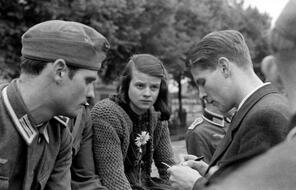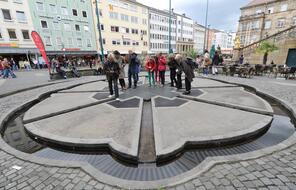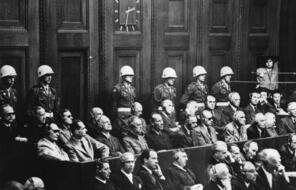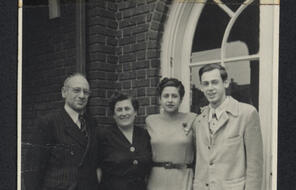Transitional Justice in Germany
At a Glance
Subject
- History
- Social Studies
- Human & Civil Rights
- The Holocaust
One of the most profound and most difficult legacies of the Holocaust is the crime of genocide itself and the wounds it left individuals and whole societies with. The oppression, violence, and mass killings changed the lives of victims and survivors; they also left a legacy that perpetrators and bystanders had to live with. Chapter 10 explored the challenge of seeking justice after genocide through the Nuremberg tribunal and other trials whose goal was to hold leading Nazis accountable for their crimes during World War II. Trials like these may be a necessary part of the search for justice after mass violence, but they leave many questions unresolved. Can a nation as a whole be held responsible for crimes? Is it possible to make amends for genocide and crimes against humanity? What is owed to the victims? Is it possible to restore peace between different groups and to repair society? These questions are the focus of “transitional justice,” the term scholars use to describe the variety of actions a society can take as it emerges from a period of war, injustice, and mass violence and tries to move toward a better future.
Legal scholar Martha Minow has explored some of the dilemmas of transitional justice. She writes:
[S]ocieties have to struggle over how much to acknowledge, whether to punish, and how to recover. How to treat the continuing presence of perpetrators, and victims, and bystanders, after the violence has ended is a central problem, or better put, series of problems. A common formulation posits the two dangers of wallowing in the past and forgetting it. Too much memory or not enough; too much enshrinement of victimhood or insufficient memorializing of victims and survivors; too much past or too little acknowledgement of the past’s staging of the present; these joined dangers accompany not just societies emerging from mass violence, but also individuals recovering from trauma.
1
In the years since World War II and the Holocaust, Germany has had to face all of these difficult questions. Immediately after the war, the Allies required that all property seized by the Nazis or transferred to them by force be returned to its rightful owners. If the rightful owner had died and left no heir, the property was to be sold and the proceeds given to organizations that helped survivors of Nazi persecution. But while some property was returned to its owners, the policy was not widely enforced. A few years later, after Germany had split into two countries, with the eastern half controlled by the Soviet Union, the new Federal Republic of Germany (also known as West Germany) adopted other policies to make restitution for wrongs committed during the war. The West German government declared that “unspeakable crimes had been committed in the name of the German people which entail an obligation to make moral and material amends.” 2 In 1953, it set up a special program to pay all those who had suffered injury or discrimination “because of the opposition to National Socialism or because of their race, creed, or ideology.” 3 The program is known in German as Wiedergutmachung, which means “to make good again.”
This program of financial reparations was controversial, complicated, and imperfect. To be eligible for reparations, an individual had to prove that he or she had been persecuted for racial, religious, or ideological reasons and had suffered injuries that were not only disabling but also the direct result of the persecution. Many victims found it difficult to meet the rigid requirements for proving persecution. Many others were excluded from the program, including Roma and Sinti victims, non-Jewish slave laborers, homosexual men who had been imprisoned, victims of forced sterilization, and families of those killed in the Nazi euthanasia program. Despite these restrictions, over the years the Wiedergutmachung program has paid more than $60 billion in reparations. 4 Some of this money was paid directly to Israel, the country founded in 1948 as a primarily Jewish state. The money supported Holocaust survivors who had settled there and was also invested to grow the country’s economy. Other reparations money has gone to support programs that assist survivors, provide Holocaust education, and work for the return of stolen Jewish property. In addition, pensions are provided to individual survivors throughout the world.
As the Wiedergutmachung program began in the early 1950s, a survey found that just 5% of Germans admitted feeling “guilty” toward Jews, and only 29% agreed that Germany owed restitution to the Jewish people. 5 Journalist Ian Buruma describes the “moral anesthesia” that Germans experienced in the years immediately after the war: “They were numbed by defeat; their memories appeared to be blocked . . . They appeared to have completely forgotten that they had glorified a leader who caused the deaths of millions.” 6 By the mid-1960s, a new generation of Germans was more willing to face the past and even to condemn the actions and inactions of their parents’ generation. Victims and their supporters continued to demand justice, and as public awareness and acknowledgement of Nazi crimes grew over the years, so did efforts to offer restitution, to repair, and to remember. Industrial companies that had used slave labor agreed to pay reparations. The Nazi theft of Jewish property, including works of art, is the focus of court cases that have continued into the twenty-first century. History classes about National Socialism and the Holocaust were mandated in all public schools in Germany. Individual towns and cities began their own projects, like the city of Berlin’s program to offer former Jewish residents all-expenses-paid trips to visit the city and meet its mayor. 7
The creation of museums and memorials has been another crucial element of coming to terms with the past in Germany. “Sites of memory,” including concentration camps and Gestapo headquarters, have been preserved and turned into museums, and hundreds of memorials have been erected in large cities and small towns. In these places, history is publicly acknowledged and visitors have the opportunity to confront the country’s past. (See the visual essay in this chapter for further discussion of memorials.) At a 2008 event commemorating the Holocaust and the liberation of Auschwitz, former Israeli ambassador to Germany Avi Primor asked, “Where in the world has one ever seen a nation that erects memorials to immortalize its own shame? Only the Germans had the bravery and the humility.” 8
Indeed, Germany’s leaders have consistently worked to connect their nation’s history with a sense of identity and responsibility. At a commemoration ceremony in 1985, then Chancellor Richard von Weizäcker said,
The vast majority of today's population were either children then or had not been born. They cannot profess a guilt of their own for crimes that they did not commit. . . . But their forefathers have left them a grave legacy. All of us, whether guilty or not, whether old or young, must accept the past. We are all affected by its consequences and liable for it. The young and old generations must and can help each other to understand why it is vital to keep alive the memories. It is not a case of coming to terms with the past. That is not possible. . . . However, anyone who closes his eyes to the past is blind to the present. Whoever refuses to remember the inhumanity is prone to new risks of infection. 9
For Germany, addressing that “grave legacy” has meant many things, including paying reparations, building memorials, and reforming education. These German efforts to make amends, to educate, and to remember are neither perfect nor complete. Not every German repudiates the crimes of World War II, and neo-Nazi groups still exist, even as the majority of people in Germany today are clearly committed to democracy and human rights. Buruma argues that contemporary Germany has changed in fundamental ways:
People are dangerous everywhere, when leaders acquire unlimited power and followers are given license to bully others weaker than themselves. Unbridled power leads to barbarousness, in individuals and mobs . . . But such is not the situation in the German Federal Republic, or indeed in Japan, today. Human nature has not changed, but politics have. In both countries, the rascals can be voted out. Those who choose to ignore that, and instead look for national marks of Cain, have learned nothing from the past. 10
Connection Questions
- What does it mean to “make good again”? Do you think it’s possible to “make good again” after genocide?
- What do you think Ian Buruma means by “moral anesthesia”? Why was it easier for some Germans to confront their history a generation after it happened?
- Which of the policies adopted in Germany seem most promising? Do any of the policies raise questions for you?
- Historian Tony Judt writes, “To ask each new generation of Germans to live forever in Hitler’s shadow, to require that they take on responsibility for the memory of Germany’s unique guilt and make it the very measure of their national identity, was the least that could be demanded—but far too much to expect.” How do Judt’s words connect with von Weizäcker’s speech? Do you agree with Judt?
- Does the definition of genocide (see reading, Raphael Lemkin and the Genocide Convention) offer any insight into what making amends for such a crime might look like? How do German attempts to “make good again” deal with different aspects of what was lost in the Holocaust? What other policies to help “make good again” can you imagine?
- Would any of the tools of transitional justice be helpful in the society where you live? How?
- 1Martha Minow, Between Vengeance and Forgiveness: Facing History after Genocide and Mass Violence (Boston, MA: Beacon Press, 1998), 2.
- 2Christian Pross, Paying for the Past: The Struggle over Reparation for Surviving Victims of the Nazi Terror (Baltimore, MD: John Hopkins University Press, 1998), 22.
- 3Christian Pross, Paying for the Past: The Struggle over Reparation for Surviving Victims of the Nazi Terror (Baltimore, MD: John Hopkins University Press, 1998), 22.
- 4“Claims Conference: History,” Conference on Jewish Material Claims Against Germany, accessed June 2, 2016.
- 5Tony Judt, Postwar: A History of Europe Since 1945 (New York: Penguin Press, 2005), 271.
- 6Ian Buruma, The Wages of Guilt: Memories of War in Germany and Japan (New York: Farrar, Straus Giroux, 1994), 24.
- 7Nicholas Kulish, “Germany Confronts Holocaust Legacy Anew,” New York Times, January 29, 2008.
- 8Nicholas Kulish, “Germany Confronts Holocaust Legacy Anew,” New York Times, January 29, 2008.
- 9“Speech by President Richard von Weizsäcker to Bundestag, May 8, 1985,” in Sources of European History: Since 1900, ed. Marvin Perry, Matthew Berg, and James Krukones (Cengage, 2010), 400.
- 10Ian Buruma, The Wages of Guilt: Memories of War in Germany and Japan (New York: Farrar, Straus Giroux, 1994), 307.
How to Cite This Reading
Facing History & Ourselves, "Transitional Justice in Germany," last updated August 2, 2016.













